A Critical Discussion of Leadership Theories in Business Operations
VerifiedAdded on 2020/01/23
|6
|1826
|87
Report
AI Summary
This report provides an in-depth analysis of leadership theories applicable to business operations. It begins with an introduction to the concept of leadership and its importance in organizational management. The main body critically discusses two prominent leadership theories: trait theory and contingency theory. Trait theory is examined for its focus on leader personality traits like intelligence and responsibility, and its assumptions about inherent leadership qualities. Contingency theory is then explored, highlighting its emphasis on situational factors influencing leadership effectiveness, including various models like the Fiedler and Path-Goal theories. The report concludes by summarizing the key takeaways and emphasizing the role of leadership theories in achieving organizational success. References to academic journals and books are also included to support the analysis.
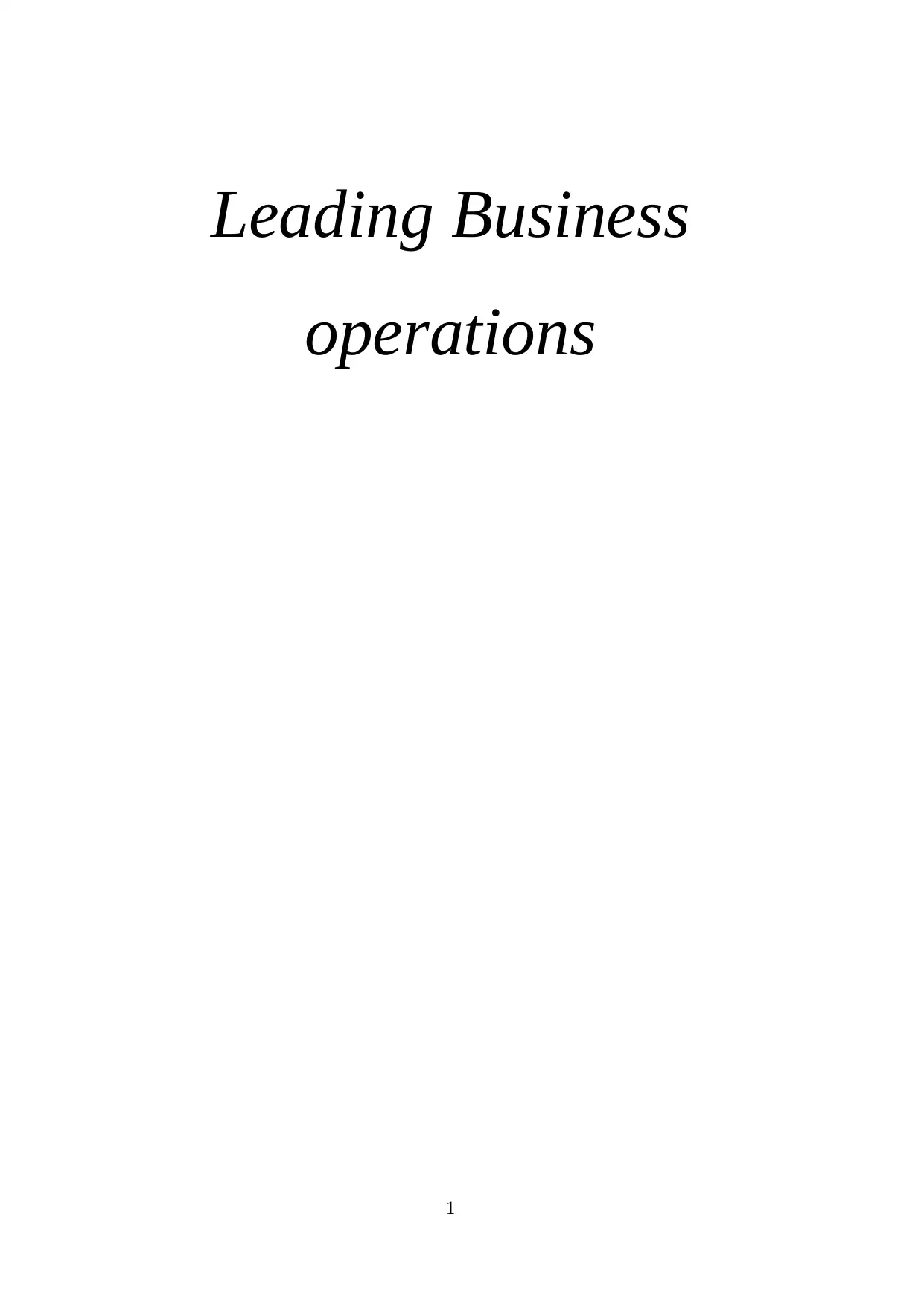
Leading Business
operations
1
operations
1
Paraphrase This Document
Need a fresh take? Get an instant paraphrase of this document with our AI Paraphraser
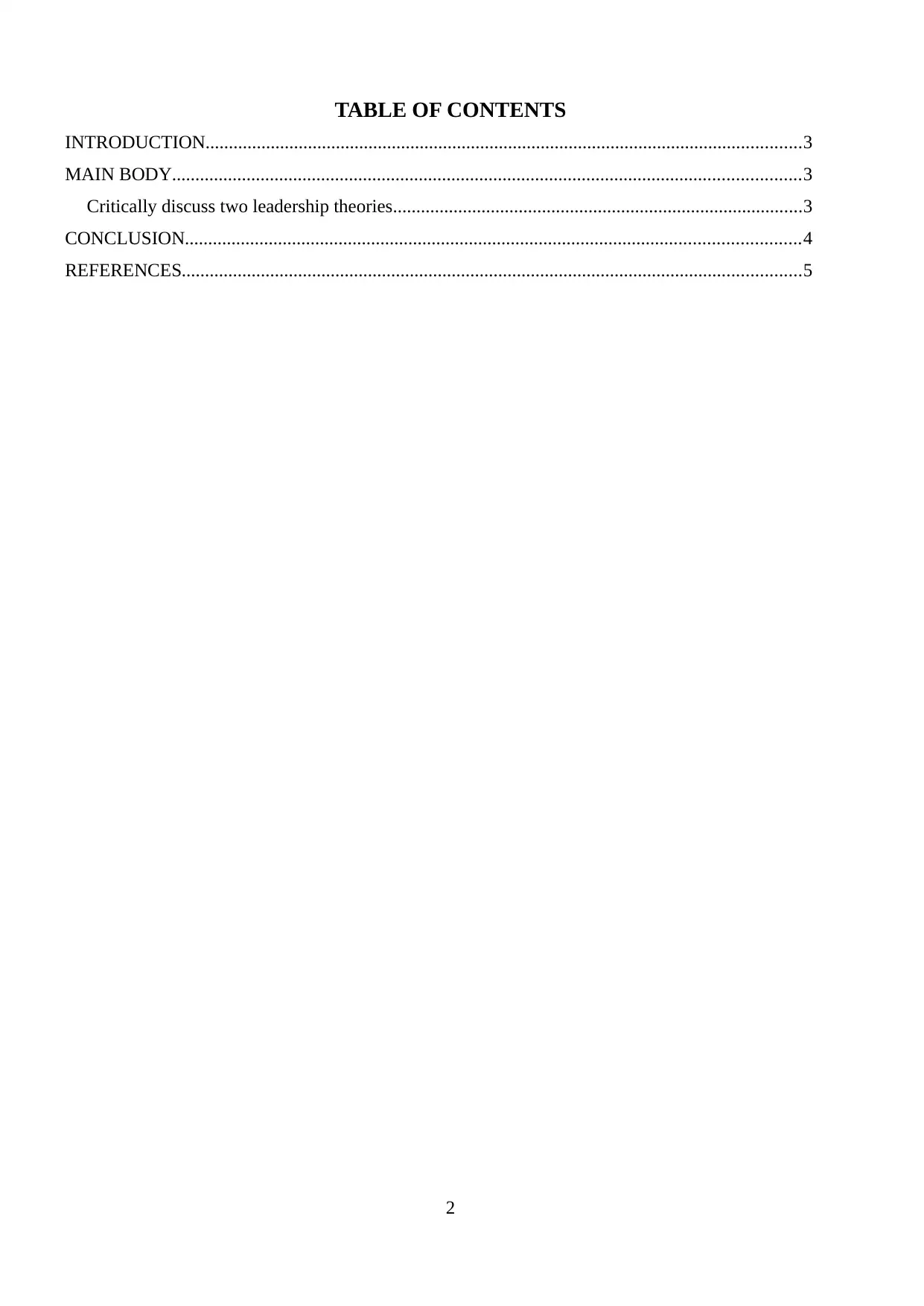
TABLE OF CONTENTS
INTRODUCTION................................................................................................................................3
MAIN BODY.......................................................................................................................................3
Critically discuss two leadership theories........................................................................................3
CONCLUSION....................................................................................................................................4
REFERENCES.....................................................................................................................................5
2
INTRODUCTION................................................................................................................................3
MAIN BODY.......................................................................................................................................3
Critically discuss two leadership theories........................................................................................3
CONCLUSION....................................................................................................................................4
REFERENCES.....................................................................................................................................5
2
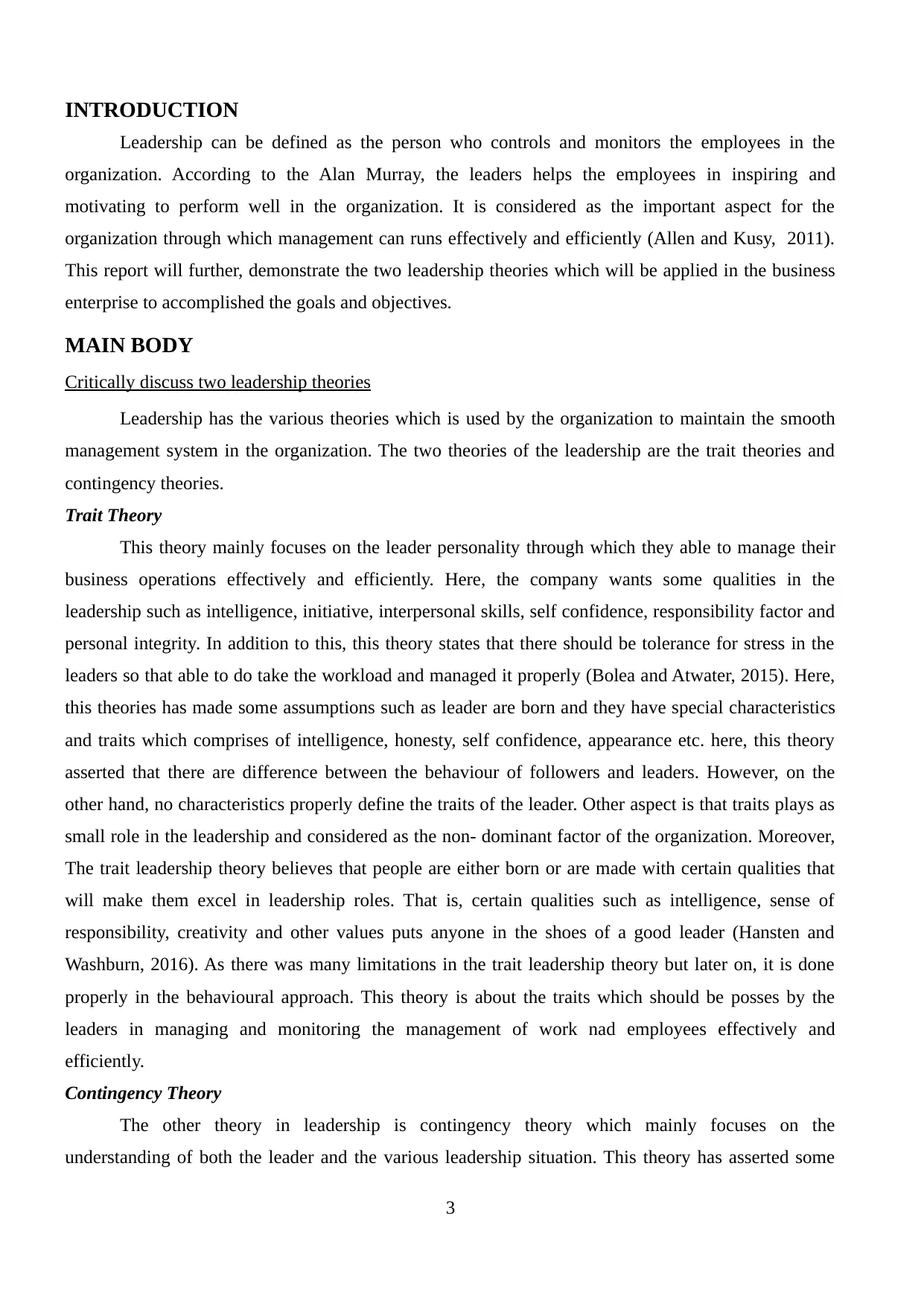
INTRODUCTION
Leadership can be defined as the person who controls and monitors the employees in the
organization. According to the Alan Murray, the leaders helps the employees in inspiring and
motivating to perform well in the organization. It is considered as the important aspect for the
organization through which management can runs effectively and efficiently (Allen and Kusy, 2011).
This report will further, demonstrate the two leadership theories which will be applied in the business
enterprise to accomplished the goals and objectives.
MAIN BODY
Critically discuss two leadership theories
Leadership has the various theories which is used by the organization to maintain the smooth
management system in the organization. The two theories of the leadership are the trait theories and
contingency theories.
Trait Theory
This theory mainly focuses on the leader personality through which they able to manage their
business operations effectively and efficiently. Here, the company wants some qualities in the
leadership such as intelligence, initiative, interpersonal skills, self confidence, responsibility factor and
personal integrity. In addition to this, this theory states that there should be tolerance for stress in the
leaders so that able to do take the workload and managed it properly (Bolea and Atwater, 2015). Here,
this theories has made some assumptions such as leader are born and they have special characteristics
and traits which comprises of intelligence, honesty, self confidence, appearance etc. here, this theory
asserted that there are difference between the behaviour of followers and leaders. However, on the
other hand, no characteristics properly define the traits of the leader. Other aspect is that traits plays as
small role in the leadership and considered as the non- dominant factor of the organization. Moreover,
The trait leadership theory believes that people are either born or are made with certain qualities that
will make them excel in leadership roles. That is, certain qualities such as intelligence, sense of
responsibility, creativity and other values puts anyone in the shoes of a good leader (Hansten and
Washburn, 2016). As there was many limitations in the trait leadership theory but later on, it is done
properly in the behavioural approach. This theory is about the traits which should be posses by the
leaders in managing and monitoring the management of work nad employees effectively and
efficiently.
Contingency Theory
The other theory in leadership is contingency theory which mainly focuses on the
understanding of both the leader and the various leadership situation. This theory has asserted some
3
Leadership can be defined as the person who controls and monitors the employees in the
organization. According to the Alan Murray, the leaders helps the employees in inspiring and
motivating to perform well in the organization. It is considered as the important aspect for the
organization through which management can runs effectively and efficiently (Allen and Kusy, 2011).
This report will further, demonstrate the two leadership theories which will be applied in the business
enterprise to accomplished the goals and objectives.
MAIN BODY
Critically discuss two leadership theories
Leadership has the various theories which is used by the organization to maintain the smooth
management system in the organization. The two theories of the leadership are the trait theories and
contingency theories.
Trait Theory
This theory mainly focuses on the leader personality through which they able to manage their
business operations effectively and efficiently. Here, the company wants some qualities in the
leadership such as intelligence, initiative, interpersonal skills, self confidence, responsibility factor and
personal integrity. In addition to this, this theory states that there should be tolerance for stress in the
leaders so that able to do take the workload and managed it properly (Bolea and Atwater, 2015). Here,
this theories has made some assumptions such as leader are born and they have special characteristics
and traits which comprises of intelligence, honesty, self confidence, appearance etc. here, this theory
asserted that there are difference between the behaviour of followers and leaders. However, on the
other hand, no characteristics properly define the traits of the leader. Other aspect is that traits plays as
small role in the leadership and considered as the non- dominant factor of the organization. Moreover,
The trait leadership theory believes that people are either born or are made with certain qualities that
will make them excel in leadership roles. That is, certain qualities such as intelligence, sense of
responsibility, creativity and other values puts anyone in the shoes of a good leader (Hansten and
Washburn, 2016). As there was many limitations in the trait leadership theory but later on, it is done
properly in the behavioural approach. This theory is about the traits which should be posses by the
leaders in managing and monitoring the management of work nad employees effectively and
efficiently.
Contingency Theory
The other theory in leadership is contingency theory which mainly focuses on the
understanding of both the leader and the various leadership situation. This theory has asserted some
3
⊘ This is a preview!⊘
Do you want full access?
Subscribe today to unlock all pages.

Trusted by 1+ million students worldwide
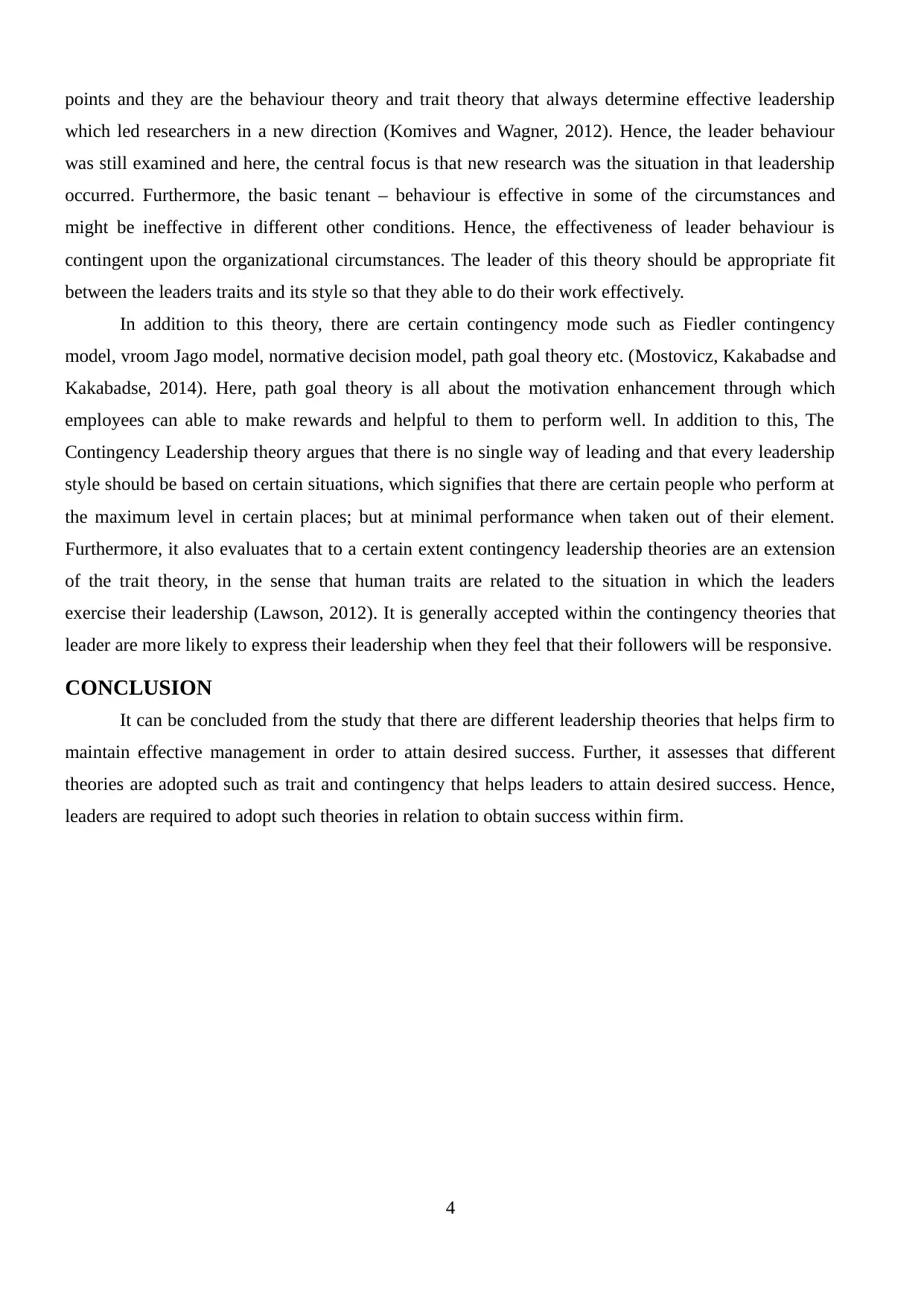
points and they are the behaviour theory and trait theory that always determine effective leadership
which led researchers in a new direction (Komives and Wagner, 2012). Hence, the leader behaviour
was still examined and here, the central focus is that new research was the situation in that leadership
occurred. Furthermore, the basic tenant – behaviour is effective in some of the circumstances and
might be ineffective in different other conditions. Hence, the effectiveness of leader behaviour is
contingent upon the organizational circumstances. The leader of this theory should be appropriate fit
between the leaders traits and its style so that they able to do their work effectively.
In addition to this theory, there are certain contingency mode such as Fiedler contingency
model, vroom Jago model, normative decision model, path goal theory etc. (Mostovicz, Kakabadse and
Kakabadse, 2014). Here, path goal theory is all about the motivation enhancement through which
employees can able to make rewards and helpful to them to perform well. In addition to this, The
Contingency Leadership theory argues that there is no single way of leading and that every leadership
style should be based on certain situations, which signifies that there are certain people who perform at
the maximum level in certain places; but at minimal performance when taken out of their element.
Furthermore, it also evaluates that to a certain extent contingency leadership theories are an extension
of the trait theory, in the sense that human traits are related to the situation in which the leaders
exercise their leadership (Lawson, 2012). It is generally accepted within the contingency theories that
leader are more likely to express their leadership when they feel that their followers will be responsive.
CONCLUSION
It can be concluded from the study that there are different leadership theories that helps firm to
maintain effective management in order to attain desired success. Further, it assesses that different
theories are adopted such as trait and contingency that helps leaders to attain desired success. Hence,
leaders are required to adopt such theories in relation to obtain success within firm.
4
which led researchers in a new direction (Komives and Wagner, 2012). Hence, the leader behaviour
was still examined and here, the central focus is that new research was the situation in that leadership
occurred. Furthermore, the basic tenant – behaviour is effective in some of the circumstances and
might be ineffective in different other conditions. Hence, the effectiveness of leader behaviour is
contingent upon the organizational circumstances. The leader of this theory should be appropriate fit
between the leaders traits and its style so that they able to do their work effectively.
In addition to this theory, there are certain contingency mode such as Fiedler contingency
model, vroom Jago model, normative decision model, path goal theory etc. (Mostovicz, Kakabadse and
Kakabadse, 2014). Here, path goal theory is all about the motivation enhancement through which
employees can able to make rewards and helpful to them to perform well. In addition to this, The
Contingency Leadership theory argues that there is no single way of leading and that every leadership
style should be based on certain situations, which signifies that there are certain people who perform at
the maximum level in certain places; but at minimal performance when taken out of their element.
Furthermore, it also evaluates that to a certain extent contingency leadership theories are an extension
of the trait theory, in the sense that human traits are related to the situation in which the leaders
exercise their leadership (Lawson, 2012). It is generally accepted within the contingency theories that
leader are more likely to express their leadership when they feel that their followers will be responsive.
CONCLUSION
It can be concluded from the study that there are different leadership theories that helps firm to
maintain effective management in order to attain desired success. Further, it assesses that different
theories are adopted such as trait and contingency that helps leaders to attain desired success. Hence,
leaders are required to adopt such theories in relation to obtain success within firm.
4
Paraphrase This Document
Need a fresh take? Get an instant paraphrase of this document with our AI Paraphraser
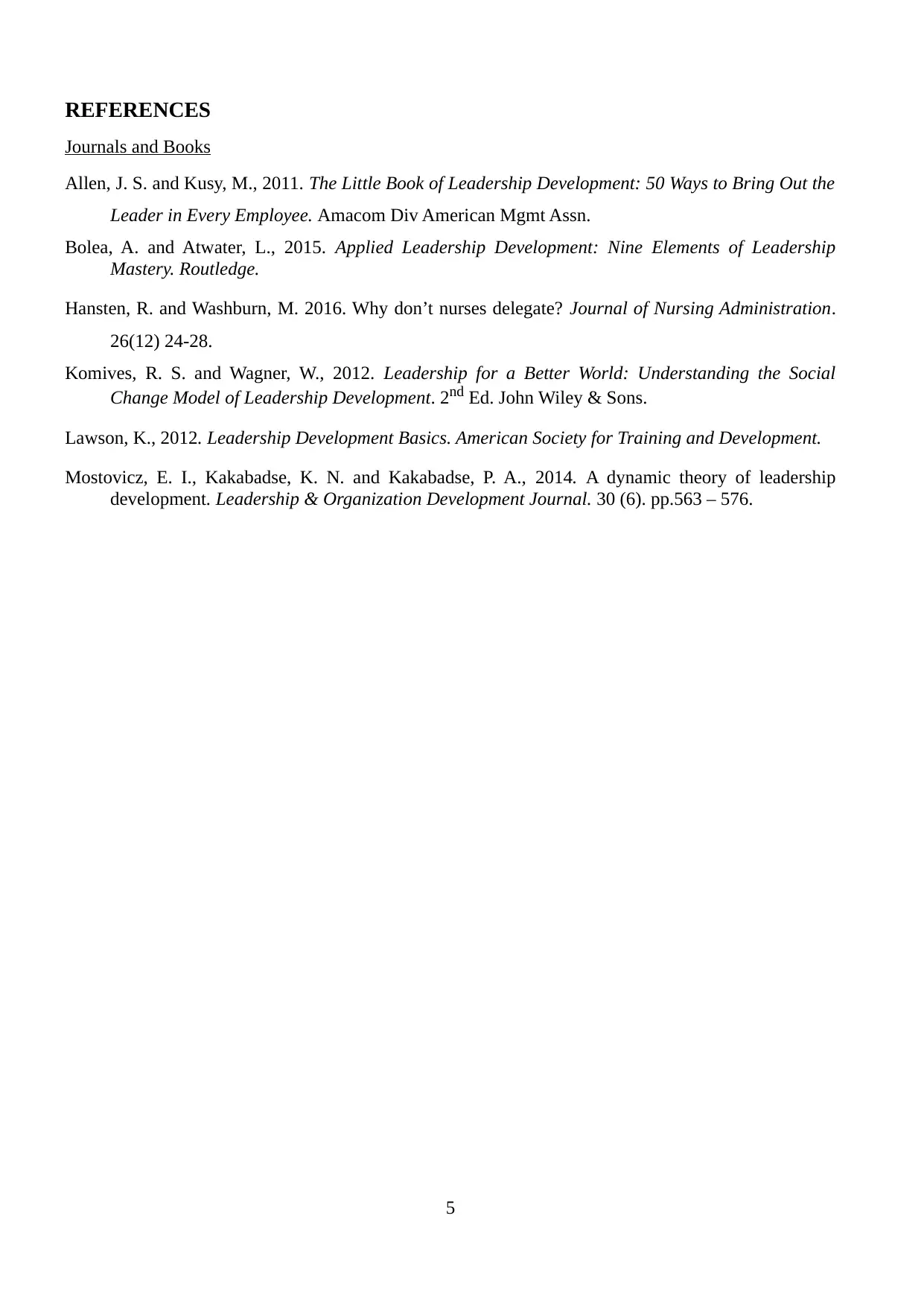
REFERENCES
Journals and Books
Allen, J. S. and Kusy, M., 2011. The Little Book of Leadership Development: 50 Ways to Bring Out the
Leader in Every Employee. Amacom Div American Mgmt Assn.
Bolea, A. and Atwater, L., 2015. Applied Leadership Development: Nine Elements of Leadership
Mastery. Routledge.
Hansten, R. and Washburn, M. 2016. Why don’t nurses delegate? Journal of Nursing Administration.
26(12) 24-28.
Komives, R. S. and Wagner, W., 2012. Leadership for a Better World: Understanding the Social
Change Model of Leadership Development. 2nd Ed. John Wiley & Sons.
Lawson, K., 2012. Leadership Development Basics. American Society for Training and Development.
Mostovicz, E. I., Kakabadse, K. N. and Kakabadse, P. A., 2014. A dynamic theory of leadership
development. Leadership & Organization Development Journal. 30 (6). pp.563 – 576.
5
Journals and Books
Allen, J. S. and Kusy, M., 2011. The Little Book of Leadership Development: 50 Ways to Bring Out the
Leader in Every Employee. Amacom Div American Mgmt Assn.
Bolea, A. and Atwater, L., 2015. Applied Leadership Development: Nine Elements of Leadership
Mastery. Routledge.
Hansten, R. and Washburn, M. 2016. Why don’t nurses delegate? Journal of Nursing Administration.
26(12) 24-28.
Komives, R. S. and Wagner, W., 2012. Leadership for a Better World: Understanding the Social
Change Model of Leadership Development. 2nd Ed. John Wiley & Sons.
Lawson, K., 2012. Leadership Development Basics. American Society for Training and Development.
Mostovicz, E. I., Kakabadse, K. N. and Kakabadse, P. A., 2014. A dynamic theory of leadership
development. Leadership & Organization Development Journal. 30 (6). pp.563 – 576.
5

Page | 6
⊘ This is a preview!⊘
Do you want full access?
Subscribe today to unlock all pages.

Trusted by 1+ million students worldwide
1 out of 6
Related Documents
Your All-in-One AI-Powered Toolkit for Academic Success.
+13062052269
info@desklib.com
Available 24*7 on WhatsApp / Email
![[object Object]](/_next/static/media/star-bottom.7253800d.svg)
Unlock your academic potential
Copyright © 2020–2025 A2Z Services. All Rights Reserved. Developed and managed by ZUCOL.





